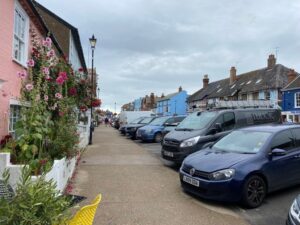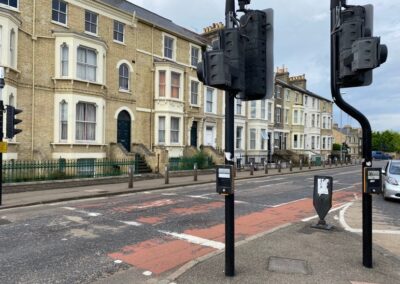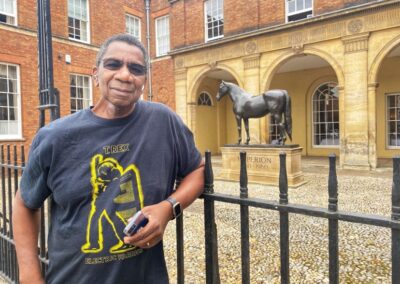Like many Canadian families, my mother’s family has its roots in Scotland, via England. Although I don’t know where my antecedents lived beyond my grandparents, I had a couple of places I very much wanted to see. Sitting at the right-hand wheel of our rental car (that’s a “hire car” over here), Dempsey was game for a road trip.
Cambridge
My grandfather, George Bruce Duncan, was born and studied in England. I think his public school (his boarding school through high school) was Rugby. When I was a child, he often talked about a once popular book called Tom Brown’s Schooldays, set at Rugby, which led me to that association. I’m not sure, however, and I hope to do more research.
I do know he took his university degree and his law degree at Cambridge. We drove north of London to the small city of Cambridge, which is in some ways reminiscent of any college town in the States. There are very nice residential neighborhoods obviously occupied by college faculty and staff, and the young people walking all over town are wearing hoodies and slouchy jeans, and carrying backpacks.
Cambridge, founded in the 13th Century when a group of academics broke away from Oxford, is an affiliation of colleges. Unfortunately, I don’t remember which college Bruce attended, so we weren’t able to see where he lived and did his daily studies.
The university itself has many newer buildings, but those are dominated architecturally by the ancient buildings that stand all through the city. Some streets we drove by were likely built in the 15th and 16th Centuries.
I walked around downtown, trying to imagine what it was like when Bruce was a student there in the early 1900s. Many of the same houses, pubs and shops were certainly there. He loved the river, and I was moved seeing today’s students rowing boats down that same waterway, passing under the same bridges and by the same buildings and gardens.
Newmarket
If we’d thought ahead, we would have taken rooms above the pub where we ate in Cambridge. Back out on the road, it was getting dark and we were somewhat disoriented. Google suggested a hotel in nearby Newmarket, a town I’d never heard of. We settled in at a Best Western located in a very old building downtown, and woke up the next morning to explore.
Newmarket has only 5600 residents, but like all the towns we drove through in the U.K., it has a robust array of services. There were buses and taxis, and several streets lined with shops, restaurants and offices. There is also a museum dedicated to horse racing, the industry that dominates the town.
When we entered town in the dark, we circled around a small park with a large statue of a beautiful horse. Driving around that morning, we found a racetrack and four separate facilities for boarding and training racehorses. On one edge of town, I saw a man riding a magnificent horse. He slowed down, and I asked permission to take his photograph. He said if we’d been there earlier, between six and ten in the morning, we’d have seen dozens of horses working out. I remarked that he seemed to love his work, and he said, “I’d better. It’s often cold and raining, and if you didn’t like it, you’d never stay.” He said Newmarket had been a racing and training center for at least 400 years.
Orford
A look at the map in the light of day showed we were actually well on our way to Aldeburgh, Suffolk, the town where my Aunt Sheila Duncan lived, at least most of her life. Just a few miles before we reached Aldeburgh, we went through Orford, on the River Alde. There’s a famous Tudor castle in the town, but we didn’t know much about that until later. We passed the Church of St. Bartholomew, and that instantly captured our attention.
We got out and walked around the churchyard. There were ancient gravestones, the engraving too old to be legible, and stones through the last several hundred years. Extending out behind the church is a line of arches, remnants of earlier construction that eventually came down as new parts were added on. The earliest building was done around 1166.
As we entered the church, we heard a magnificent organ playing. The man at the keys introduced himself as David. He said he’d come just to play the organ, which the church had acquired in 2017 from a venue in Southampton, where he had heard it some years before. He also told us the church has provided space for musical performances over the years, which is why a large portion of the interior is open.
There is a green slate slab set in the floor commemorating Benjamin Britten, the famous Aldeburgh-born composer who presented his work in the church. One of the most striking elements of the church is a 15th century baptismal font.
The English had been Christians since Roman times, converting the various groups who came to the island to stay. When the Normans invaded in 1066, however, they undertook the building of large stone edifices from which the clergy would reinforce the Norman authority. Today there are thousands of historic churches in the United Kingdom, although in England, as in other countries, fewer people attend church on a regular basis.
On our way out of Orford, we took the wrong route and ended up at a small landing on the river. To one side was a beach, and to the other boats provided river excursions or sold their daily catch of fish. It was a charming town we could have explored longer. But we were eager to reach Aldeburgh, just a few miles away.
Aldeburgh
My Aunt Sheila was Bruce’s younger sister. She was engaged to a young man who – like so many other Englishmen of his generation – died in World War I.
Bruce himself was injured twice in the war. While he was recovering in a French hospital he exchanged letters with my grandmother, Dorothy Ponsonby Gordon, whom he’d met on an earlier trip to Vancouver. Writing letters to the boys in Europe was a way for young women of her social group to support the war effort, but for Dorothy it turned into more. After the war, Bruce moved to Vancouver, married my Gaga, and started his law practice there.
I don’t know if she and Bruce and my Uncle Grant grew up in Edinburgh, but Sheila lived there until her death at ninety-six. Bruce and Dorothy and Mummy visited her a number of times, and she made a couple of trips to Vancouver and to Texas.
She often wrote to us. She never owned a car, as she had the train whenever she went to London, and she rode her bike all over Aldeburgh. She wrote that at ninety-four she had decided her balance precluded further bike riding, and she was getting around town walking. When Dempsey and I saw the town, which sits on a series of hills ascending from the wide North Sea beach, we understood why.
Sheila owned a house. Though I can see her letters in my mind’s eye, I cannot remember her address, so we weren’t able to see where she lived. She was financially self-sufficient, and she enjoyed being a useful part of a small-town community. Aldeburgh is known as a center for arts and literature, and there is an annual poetry festival. I expect there are some old people there who may remember her, although I didn’t have time to investigate further.
Like its neighbors, Aldeburgh has a long history. Its name, ald (meaning old) and burh (fortification), indicate it was a fortified town long before the Normans arrived. It was a shipbuilding center, and the flagship of the Virginia Company is thought to have been built there in 1608. Its shipbuilding industry and many of the old Tudor buildings were lost as silt built up in the River Alde and large ships could no longer navigate its harbor. There is now a yacht and a sailing club on the river.
Aldeburgh has about 2300 citizens; many of the homes are owned by Londoners as a getaway from the city. There are two bookstores, which along with the beach, makes it my kind of town. We ate at a great Italian restaurant. According to someone online, two of the best fish and chips restaurants in the country are in Aldeburgh.















0 Comments